Blockchain Technology: Potential Applications for Public Sector E-Procurement and Project Management
Abstract
1. Introduction
- Investigate the issues that affect the successful implementation of the public sector infrastructure projects in developing/developed countries;
- Identify the possible application of Blockchain in project and procurement management;
- Develop a guideline to incorporate Blockchain into project management for improving the existing project and procurement management practices in developing countries, such as Bangladesh.
2. Literature Review and Theoretical Background
2.1. Projects vs. Project Management
2.2. Project Implementation Problem of the Public Sector Projects
2.2.1. Project Implementation Problems in Developing Countries
2.2.2. Issues Affecting the Public Sector Projects
2.3. Blockchain
2.3.1. What Is Blockchain Technology?
2.3.2. Why Is Blockchain Unique?
2.4. Possible Applications of Blockchain Technology in Project Management
2.4.1. E-Procurement/Comprehensive Administration by Oracle Blockchain Platform
E-Procurements or Comprehensive Administration
Components for Blockchai-Based E-Procurements System
E-procurement through Cloud/Blockchain Platform
3. Findings
3.1. Advantages and Risks of Blockchain-Based E-Procurement System
3.1.1. Legal Advantages
- (a)
- E-procurement: E-procurement is the main legal advantage of Blockchain-based project management. Blockchain-based project management will enable them to do all the procurement processes online [41]. Additionally, it will enable the shift from a paper-based procurement system to a paperless/online-based procurement system.
- (b)
- On-time tendering system: The delay in the tendering process is a common problem in developing countries. Due to this, infrastructure-related public sector projects are delayed in developing countries [41,57]. However, due to its automation and less human effort, all the procurement steps will be able to be complete within the assigned/allocated time against each step. Therefore, if Blockchain-based project management followed, then it is expected that the tendering process will be finished within the planned time of all projects.
- (c)
- Transparency: A lack of transparency is one of the main reasons for delaying public sector infrastructure-related projects in developing countries [35,36,57]. Blockchain-based project management ensures a secure and private network between the users. All the associated members of different organisations, and even top management, will be able to follow the task during the project’s duration [41,51]. Therefore, all the project-related tasks during the project’s processing and implementation will be transparent to everyone involved with the project.
- (d)
- Accountability: Poor accountability is another major problem in project management. A project may fail due to individuals making poor decisions [35]. When something goes wrong with a project, no one takes the responsibility for delaying public sector projects in developing countries. However, Blockchain is considered a digital ledger for any online transactions [14]. Additionally, it is not possible to either alter, delete, or change any Blockchain-based information without the permission of all concerned persons [51]. Therefore, it will become straightforward to identify the accountable person/organisation for whom any task has been delayed by.
- (e)
- Secured network system: All the nodes and APIs (Application Programming Interface) need to be designed for a specific project; therefore, the Blockchain network is considered to be the most secure network. Furthermore, the system updates automatically [51]. Therefore, the network will be trusted by the owner and the vendor [30,57,58].
- (f)
- Lowest bidder issue: The lowest bidder issue is one of the common and important issues discussed by the different researchers [32,36,41]. Due to avariety of reasons, the lowest and winner bidder increases the cost and duration of the project. However, with the Blockchain project management system, if any vendor failed to finish a project within the contracted time and cost without any valid reason, then the vendor may be punished by liquidated damages, or ministries may have the authority to blacklist the vendor.
- (g)
- Provenance of materials: Blockchain provides the facility of the vendors/contractors to participate in bidding from all over the world. It opens the opportunities to choose the best vendor. Furthermore, the buyer can monitor the production of materials to ensure the quality of materials [19].
3.1.2. Managerial Advantages
3.1.3. Financial Advantages
3.1.4. Organisational Advantages
3.1.5. Risks of Blockchain
- A loss of data and identity;
- The transaction costs of the public Blockchain, which are high;
- A lack of recipients and users;
- A lack of long-term experience, which leads to imperfect management;
- The initial applications, which may have technical problems.
- A lack of a standardized mode of operation and function, as well as security deficiencies.
- There may be fraud in the interface between the real world and the Blockchain world;
- The exchange may be attacked by hackers, the user passwords may be hacked, and the funds transferred;
- The hard fork in the block will cause the trust of the entire network system to be questioned.
- Tax evasion may be triggered;
- Illegal use of information may occur;
- Blockchains are used for illegal transactions.
3.1.6. Application of Blockchain Technology in Project Management
3.1.7. Authentic Financial Transactions and Digital Payments through Oracle Blockchain Platform
3.1.8. Automated Document Management
3.2. Potential of the Blockchain Technology to Mitigate the Existing Project Management Risks
4. Discussion and Contributions
4.1. Conceptual Framework for E-Procurement in Bangladesh
- (i)
- Use case identification: In Bangladesh, public sector projects are mainly approved by ECNEC. However, the small projects (based on cost) with conditions are approved by the Honourable Minister of Ministries. Then, before starting the procurement by the agencies after the required components, the cost, duration, and other criteria are finalized according to Digital Procurement Platform (DPP).
- (ii)
- Creating the account and consensus mechanisms: A project director/project manager is assigned by the ministry immediately after the final approval of a project in Bangladesh. In the next step, the project manager will open an account in Blockchain-based service provider websites, such as Oracle. Account verification is an essential step to opening an account. After opening an account, the private and public keys will generate against the account [41]. There are different types of Blockchain platforms provided by the different service providers, such as:
- The Standard Edition: two OCPUs, 50 GB storage, two peers (additional peers can be added later) [30]. The OCPU is the Oracle Compute Unit per hour. Higher capacity options are also available.
- (iii)
- Buyer/supplier: In government projects, all the procurement deals are for buying either goods, works, or services; therefore, the project manager or the IT team of the project should deal as a buyer [30].
- (iv)
- Designing the nodes: The node design is a part of the Blockchain platform. It mainly provides permissions regarding who will be able to access the platform [59]. Therefore, during the bidding process, it will be open for all. After that, it will remain open for specific government organisations, such as the Ministry, Planning Commission, IMED, concerned agency, etc.
- (v)
- Building the API and creating/posting advertisements: The next step is very important as it deals with the Blockchain post based on the project requirements. An API is needed at this stage [30,59]. It may also be called the user interface. Various programming languages can be used to create the API, such as HTML5, CSS, PHP, C#, Java, Javascript, Python, Ruby, Golang, Solidity, Angular JS Nodejs, MySQL, and MongoDB [59]. A chain code is created through the API.
- (vi)
- Approval of procurement posts/advertisements: The project team will send a request to the CPTU (Central Procurement Technical Unit) for the approval of the post, as the CPTU controls the E-procurement of Bangladesh. The Blockchain address of the post will generate after the approval of the post by the CPTU.
- (vii)
- Procurement post/advertisement publication in the dashboard: Next, the advertisement will become available in the dashboard. Then, all the contractors/vendors will participate in getting the task, and the owner will wait for the bidder.
- (viii)
- Bidders’ participation: In this stage, all the vendors will be allowed to participate in the bidding process within the allocated time. When vendors will submit their bid, then they will receive a Blockchain-notarized receipt.
- (ix)
- Bidders’ rankings: Later, bidders will be ranked according to their price and other conditions. The project team, agency, and the concerned ministry will finalize the evaluation conditions of the vendor. Finally, the top-ranked vendor will be negotiated for the contract. If the top-ranked vendor agrees with the owner of the contract, then the vendor will be finalised [41].
- (x)
- Creating a smart contract with a multi-signature protocol: Deploying the chain code, the multi-signature protocol needed to create a smart contract, is done in this stage (Thio-Ac et al., 2019b). This stage is very important because all the government policies and fund release conditions will be integrated within the system, such as after the field visit of IMED, the fund will be released by the concerned ministry (if the task meets all the criteria). Otherwise, the ministry will not release the fund against the project.
- (xi)
- Notification of award (NOA): A NOA will be issued after creating the smart contract. The NOA will be notarized using the Blockchain platform and after that, it will be sent to all concerned stakeholders according to the law/policy of Bangladesh [41].
- (xii)
- Commencing the project/work package: Finally, the vendor will start working for the project according to the timeline of the project.
4.2. Future Research Agenda
- (a)
- Blockchain technology is a new technology. Hence, the researcher can try to find other applications of this technology which might support managing projects.
- (b)
- ICT sector researchers can research developing the Blockchain platform and the API (Application Programming Interface) for experimenting on the overall efficiency and performance of Blockchain-based project management;
- (c)
- Further research can be done to develop a Blockchain-based E-procurement system for public sector projects in the context of developing countries.
5. Conclusions
Author Contributions
Funding
Institutional Review Board Statement
Informed Consent Statement
Data Availability Statement
Conflicts of Interest
References
- Abdullah, R.; Faizal, M. Block Chain: Cryptographic Method in Fourth Industrial Revolution. Int. J. Comput. Netw. Inf. Secur. 2018, 9, 9–17. [Google Scholar]
- Zarewa, G.; Ibrahim, A.; Ibrahim, Y.; Adogbo, K. Governance Impact Assessment on Large Infrastructure Project (LIP) Delivery. J. Eng. Proj. Prod. Manag. 2018, 8, 9–21. [Google Scholar] [CrossRef]
- De Mascia, S. Project Psychology: Using Psychological Models and Techniques to Create a Successful Project; Routledge: London, UK, 2016. [Google Scholar]
- Özkan, E.; Azizi, N.; Haass, O. Leveraging Smart Contract in Project Procurement through DLT to Gain Sustainable Competitive Advantages. Sustainability 2021, 13, 13380. [Google Scholar] [CrossRef]
- Ezzat, A. Challenges of mega construction projects in developing countries. Organ. Technol. Manag. Constr. 2013, 5, 730–746. [Google Scholar]
- Siddique, S.; Ahsan, A.; Azizi, N.; Haass, O. Students’ Workplace Readiness: Assessment and Skill-Building for Graduate Employability. Sustainability 2022, 14, 1749. [Google Scholar] [CrossRef]
- Khalfan, M.; McDermott, P.; Cooper, R. Integrating the supply chain within construction industry. In Proceedings of the 20th ARCOM Conference, Edinburgh, UK, 1–3 September 2004; Volume 2, pp. 897–904. [Google Scholar]
- Jelena, M.A.; Abdul-Majeed, M.; Jiayuan, W.; Patrick, X.W.Z.; Ruoyu, Z. The cost performance and causes of overruns in infrastructure development projects in Asia. J. Civ. Eng. Manag. 2019, 25, 203–214. [Google Scholar]
- IMED: Implementation Monitoring and Evaluation Division 2019—Project Completion Report FY 2016-17. Available online: https://imed.portal.gov.bd/sites/default/files/files/imed.portal.gov.bd/page/315d64be_c080_478a_8b14_fddea2e03f02/road%20division_part_2.pdf (accessed on 1 March 2020).
- Khalfan, M.M.A.; McDermott, P.; Oyegoke, A.S.; Dickinson, M.T.; Li, X. Application of Kanban in the UK Construction Industry by Public Sector Clients. In Proceedings of the 16th Annual Conference of the International Group for Lean Construction, Manchester, UK, 16–18 July 2008; pp. 347–357. [Google Scholar]
- Oladapo, A. A quantitative assessment of the cost and time impact of variation orders on construction projects. J. Eng. Des. Technol. 2007, 5, 35–48. [Google Scholar] [CrossRef]
- Azizi, N.; Malekzadeh, H.; Akhavan, P.; Haass, O.; Saremi, S.; Mirjalili, S. IoT–Blockchain: Harnessing the Power of Internet of Thing and Blockchain for Smart Supply Chain. Sensors 2021, 21, 6048. [Google Scholar] [CrossRef]
- Risius, M.; Spohrer, K. A Blockchain Research Framework. Bus. Inf. Syst. Eng. 2017, 59, 385–409. [Google Scholar] [CrossRef]
- Carlozo, L. What is blockchain? J. Account. 2017, 224, 29. [Google Scholar]
- Gausdal, A.; Czachorowski, K.; Solesvik, M. Applying Blockchain Technology: Evidence from Norwegian Companies. Sustainability 2018, 10, 1985. [Google Scholar] [CrossRef]
- Haass, O.; Azizi, N. Challenges and solutions across project life cycle: A knowledge sharing perspective. Int. J. Proj. Organ. Manag. 2020, 12, 346–379. [Google Scholar] [CrossRef]
- Denter, N.M.; Seeger, F.; Moehrle, M.G. How can Blockchain technology support patent management? A systematic literature review. Int. J. Inf. Manag. 2022, 102506. [Google Scholar] [CrossRef]
- McDermott, P.; Khalfan, M. Achieving Supply Chain Integration within Construction Industry. Constr. Econ. Build. 2006, 6, 44–54. [Google Scholar] [CrossRef]
- Rana, N.P.; Dwivedi, Y.K.; Hughes, D.L. Analysis of challenges for blockchain adoption within the Indian public sector: An interpretive structural modelling approach. Inf. Technol. People 2021, 35, 548–576. [Google Scholar] [CrossRef]
- Azizi, N.; Akhavan, P.; Philsoophian, M.; Davison, C.; Haass, O.; Saremi, S. Exploring the Factors Affecting Sustainable Human Resource Productivity in Railway Lines. Sustainability 2022, 14, 225. [Google Scholar] [CrossRef]
- Shojaei, A.; Wang, J.; Fenner, A. Exploring the feasibility of blockchain technology as an infrastructure for improving built asset sustainability. Built Environ. Proj. Asset Manag. 2019, 10, 184–199. [Google Scholar] [CrossRef]
- Schweizer, A.; Knoll, P.; Urbach, N.; von der Gracht, H.A.; Hardjono, T. To what extent will blockchain drive the machine economy? Perspectives from a prospective study. IEEE Trans. Eng. Manag. 2020, 67, 1169–1183. [Google Scholar] [CrossRef]
- Azizi, N.; Rowlands, B. Developing an IT Risk Management Culture Framework. In ICT for an Inclusive World; Springer: Cham, Switzerland, 2020; pp. 483–491. [Google Scholar]
- Idrees, S.M.; Nowostawski, M.; Jameel, R.; Mourya, A.K. Security Aspects of Blockchain Technology Intended for Industrial Applications. Electronics 2021, 10, 951. [Google Scholar] [CrossRef]
- Oracle. Oracle, 2020a, Oracle Blockchain; Oracle: Austin, TX, USA, 2020; Available online: https://www.oracle.com/blockchain/ (accessed on 3 July 2020).
- Oracle. Oracle, 2020b, Blockchain Platform; Oracle: Austin, TX, USA, 2020; Available online: https://www.oracle.com/au/index.html (accessed on 4 July 2020).
- Aditya, A.; Douglass, D.; Bhattacharya, M. Urban Infrastructure Development Works in India: Delay and Difficulties in Implementation with Reference to a Water Supply Project. Civ. Archit. Environ. Agric. Eng. 2017, 98, 349–354. [Google Scholar] [CrossRef][Green Version]
- Project Management Institute. A Guide to the Project Management Body of Knowledge (PMBOK Guide), 6th ed.; Project Management Institute: Newtown Square, PA, USA, 2017. [Google Scholar]
- Atkinson, R. Project management: Cost, time and quality, two best guesses and a phenomenon, it’s time to accept other success criteria. Int. J. Proj. Manag. 1999, 17, 337–342. [Google Scholar] [CrossRef]
- Oracle. Oracle, 2020c, Securely, Reliably Extend Business Processes and Accelerate B2B Transactions; Oracle: Austin, TX, USA, 2020; Available online: https://www.oracle.com/au/application-development/cloud-services/blockchain-platform/ (accessed on 6 July 2020).
- Lester, A. Project Management, Planning and Control: Managing Engineering, Construction and Manufacturing Projects to PMI, APM and BSI Standards, 7th ed.; Butterworth-Heinemann: Oxford, UK, 2017. [Google Scholar]
- Park, Y.-I.; Papadopoulou, T. Causes of cost overruns in transport infrastructure projects in Asia. Their significance and relationship with project size. Built Environ. Proj. Asset Manag. 2012, 2, 195–216. [Google Scholar] [CrossRef]
- Gamez, E.A.; Touran, A. A Quantitative Analysis of the Performance of Transportation Projects in Developing Countries. Transp. Rev. 2010, 30, 361–387. [Google Scholar] [CrossRef]
- Haass, O.; Azizi, N. Knowledge sharing practice in project-oriented organisations: A practical framework based on project life cycle and project management body of knowledge. Int. J. Proj. Organ. Manag. 2019, 11, 171–197. [Google Scholar]
- Bruzelius, N.; Flyvbjerg, B.; Rothengatter, W. Big decisions, big risks. Improving accountability in mega projects. Transp. Policy 2002, 9, 143–154. [Google Scholar] [CrossRef]
- Islam, M.; Suhariadi, B. Construction delays in privately funded large building projects in Bangladesh. Build. Hous. 2018, 19, 415–429. [Google Scholar] [CrossRef]
- Infrastructure Governance Challenges; OECD Publishing: Paris, France, 2017.
- Mahamadu, A.-M.; Manu, P.; Booth, C.; Olomolaiye, P.; Coker, A.; Ibrahim, A.; Lamond, J. Infrastructure procurement skills gap amongst procurement personnel in Nigeria’s public sector. J. Eng. Des. Technol. 2018, 16, 2–24. [Google Scholar] [CrossRef]
- Naveed, K.M.; Muhammad, F.K. Comparative Analysis of Similar Public Sector Projects with Different Success Outcome. J. Strategy Perform. Manag. 2019, 7, 106–132. [Google Scholar]
- Priemus, H. Decision-making on Large Infrastructure Projects: The Role of the Dutch Parliament. Transp. Plan. Technol. 2007, 30, 71–93. [Google Scholar] [CrossRef]
- Thio-Ac, A.; Serut, A.; Torrejos, R.; Rivo, K.; Velasco, J. 2019a Blockchain-based System Evaluation: The Effectiveness of Blockchain on E-Procurements. arXiv 2019, arXiv:1911.05399. [Google Scholar]
- Zachariadis, M.; Hileman, G.; Scott, S.V. Governance and control in distributed ledgers: Understanding the challenges facing blockchain technology in financial services. Inf. Organ. 2019, 29, 105–117. [Google Scholar] [CrossRef]
- Yang, Y.; Chen, J.; Liu, M. Application of blockchain in internet of things. In Proceedings of the International Conference on Cloud Computing and Security, Haikou, China, 8–10 June 2018; Springer: Cham, Switzerland, 2018; pp. 73–82. [Google Scholar]
- Khalfan, M.; Noor, M.A.; Maqsood, T.; Alshanbri, N.; Sagoo, A. Perceptions towards sustainable construction amongst construction contractors in state of Victoria, Australia. J. Econ. Bus. Manag. 2015, 3, 940–947. [Google Scholar] [CrossRef][Green Version]
- Atlam, H.; Alenezi, A.; Alassafi, M.; Wills, G. Blockchain with Internet of Things: Benefits, Challenges, and Future Directions. Int. J. Intell. Syst. Appl. 2018, 10, 40. [Google Scholar] [CrossRef]
- Ammous, S. Blockchain Technology: What Is It Good For? Bank. Financ. Law Rev. 2019, 34, 251. [Google Scholar] [CrossRef]
- Antony, J.; Gupta, S. Top ten reasons for process improvement project failures. Int. J. Lean Six Sigma 2019, 10, 367–374. [Google Scholar] [CrossRef]
- Nowiński, W.; Kozma, M. How Can Blockchain Technology Disrupt Existing Business Models? Entrep. Bus. Econ. Rev. 2017, 5, 173–188. [Google Scholar] [CrossRef]
- Asad, S.; Khalfan, M.M.A. Integration of Sustainability Issues within Construction Processes. Emir. J. Eng. Res. 2007, 12, 11–21. [Google Scholar]
- Khalfan, M.M.A.; Bouchlaghem, N.M.; Anumba, C.J.; Carrillo, P.M. Knowledge Management for Sustainable Construction: The C-SanD Project. In Proceedings of the Construction Research Congress—Wind of Change: Integration and Innovation, Honolulu, Hawaii, 19–21 March 2003. [Google Scholar]
- Welfare, A. Commercializing Blockchain: Strategic Applications in the Real World; Wiley: Chichester, UK, 2019. [Google Scholar]
- Notheisen, B.; Cholewa, J.; Shanmugam, A. Trading Real-World Assets on Blockchain. Bus. Inf. Syst. Eng. 2017, 59, 425–440. [Google Scholar] [CrossRef]
- Tran, M. The Top 10 Cloud Platforms Australian Businesses Are Using. 2019. Available online: https://www.ddls.com.au/blog/the-top-10-cloud-platforms-australian-businesses-are-using/ (accessed on 3 July 2020).
- Christodoulou, P.; Christodoulou, K.; Andreou, A. A Decentralized Application for Logistics: Using Blockchain in Real-World Applications. Cyprus Rev. 2018, 30, 181–193. [Google Scholar]
- Kitchenham, B. Procedures for Performing Systematic Reviews; Keele University: Keele, UK, 2004; Volume 33, pp. 1–26. [Google Scholar]
- Francisco, K.; Swanson, D. The Supply Chain Has No Clothes: Technology Adoption of Blockchain for Supply Chain Transparency. Logistics 2018, 2, 2. [Google Scholar] [CrossRef]
- Lu, H.; Huang, K.; Azimi, M.; Guo, L. Blockchain technology in the oil and gas industry: A review of applications, opportunities, challenges, and risks. IEEE Access 2019, 7, 41426–41444. [Google Scholar] [CrossRef]
- Oracle. Oracle, 2020f, Designed for Business User: Intelligent Track and Trace; Oracle: Austin, TX, USA, 2020; Available online: https://www.oracle.com/uk/scm/track-and-trace/ (accessed on 30 July 2020).
- Nagpal, S. Cryptocurrency: The Revolutionary Future Money. 2017. Available online: https://papers.ssrn.com/sol3/papers.cfm?abstract_id=3090813 (accessed on 20 December 2021).
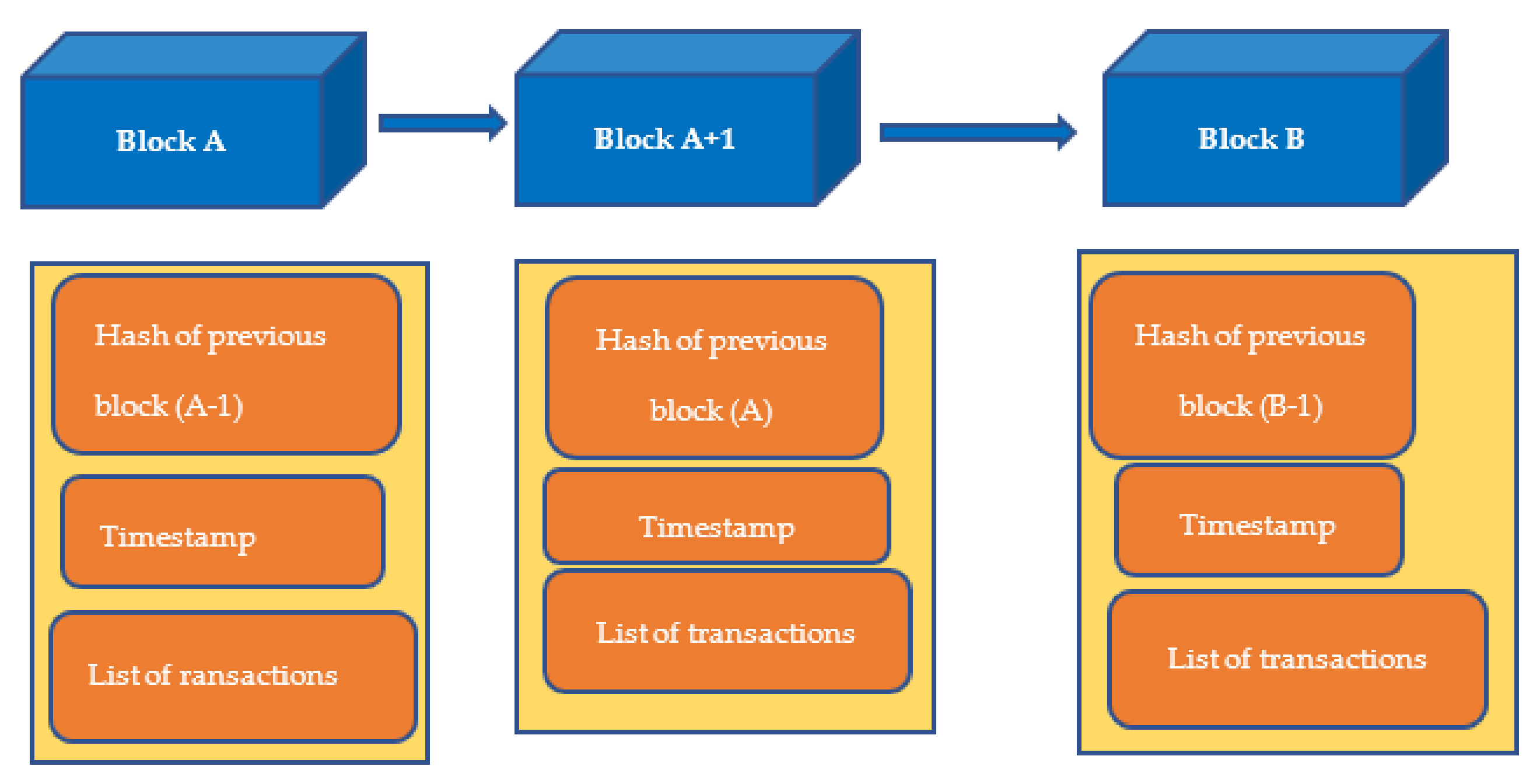
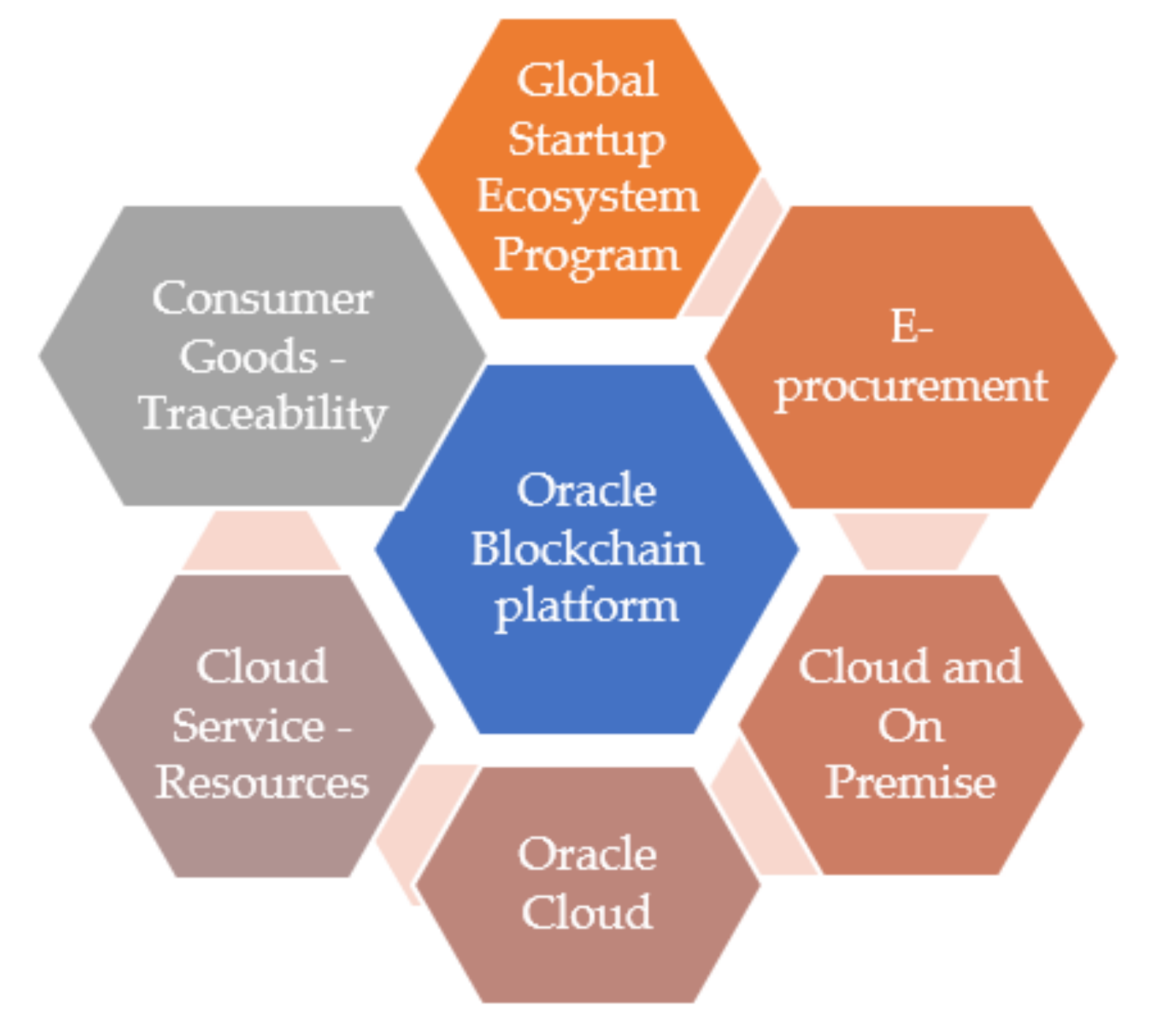
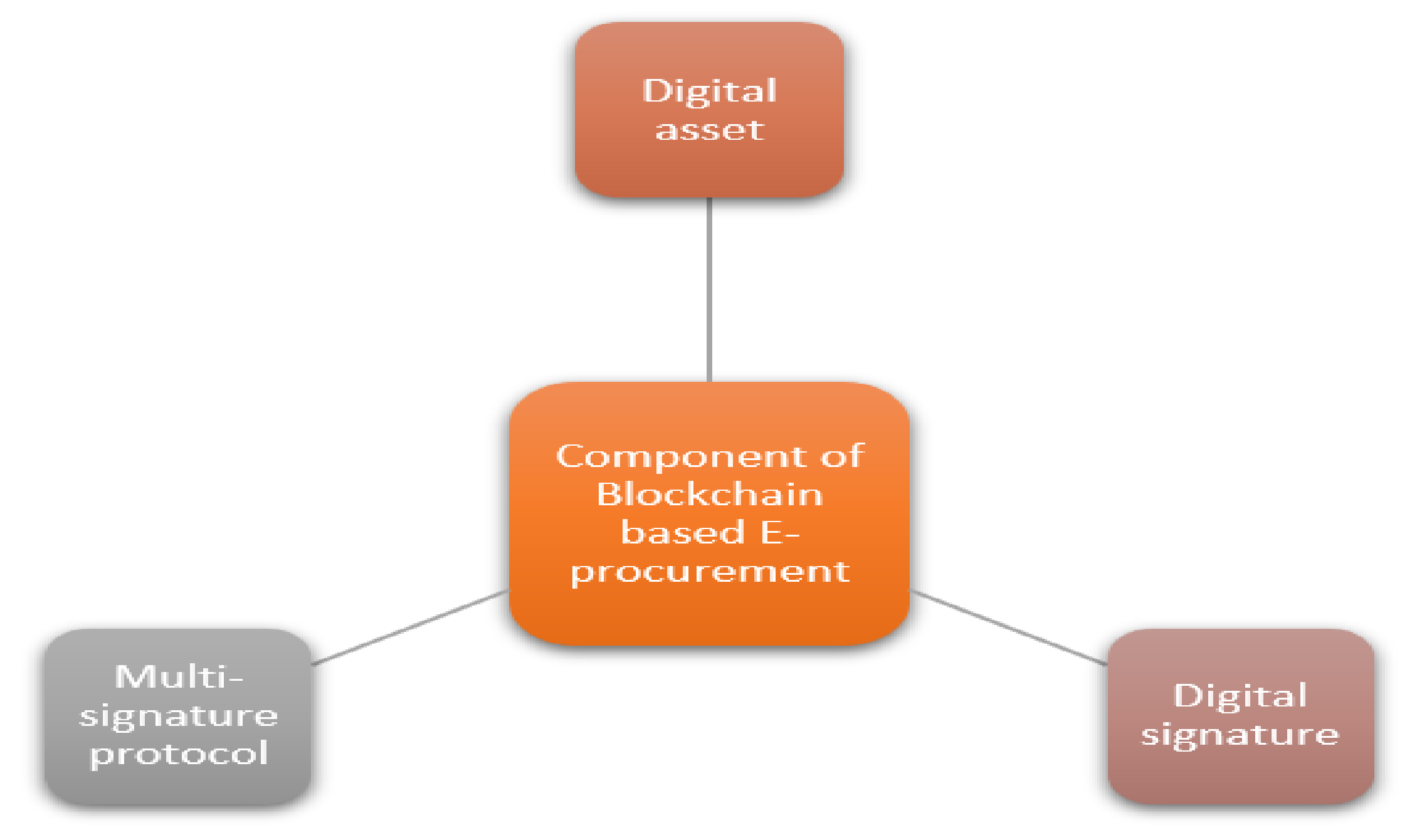
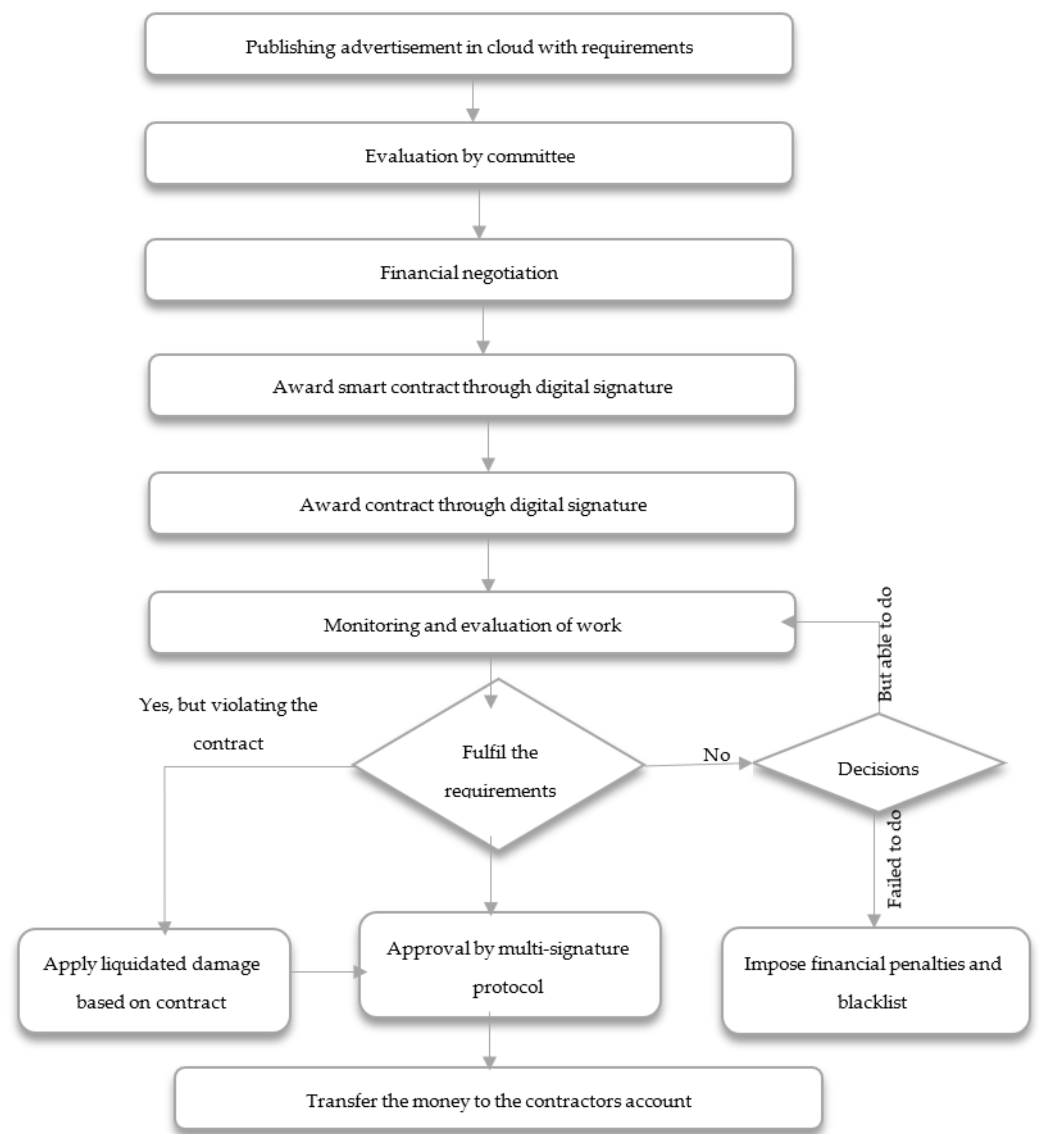
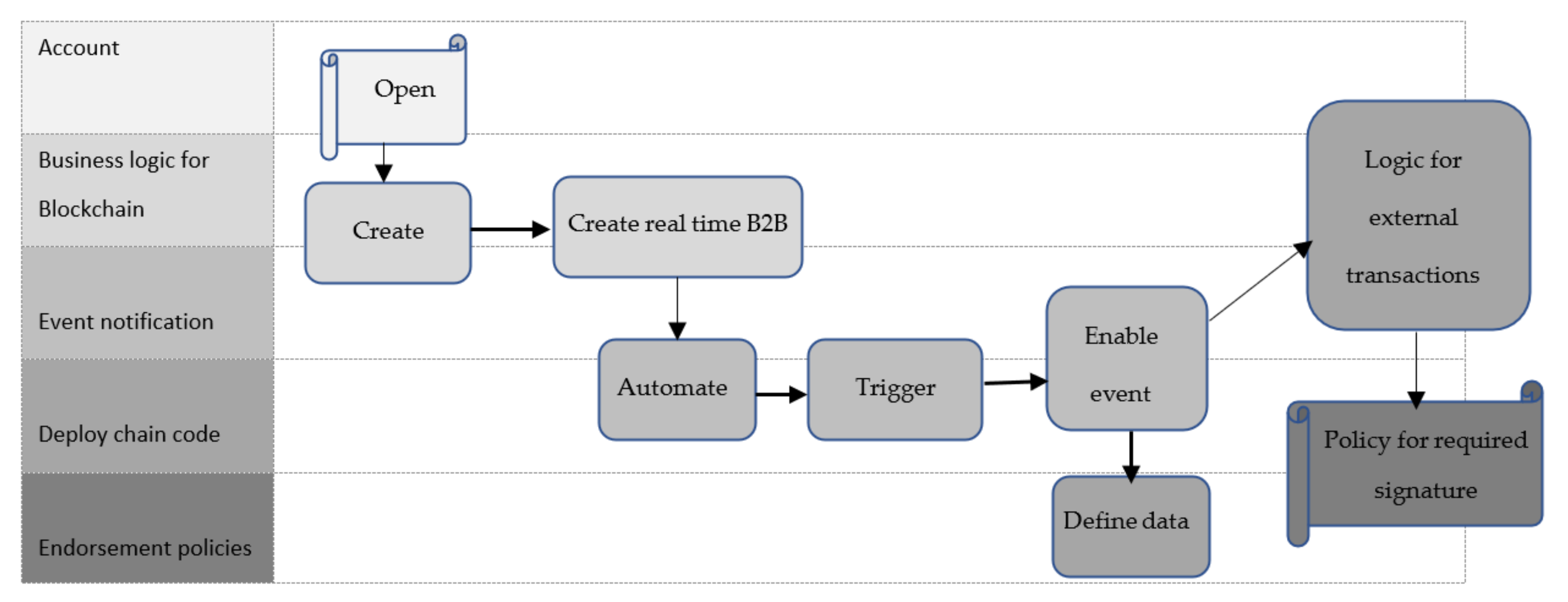
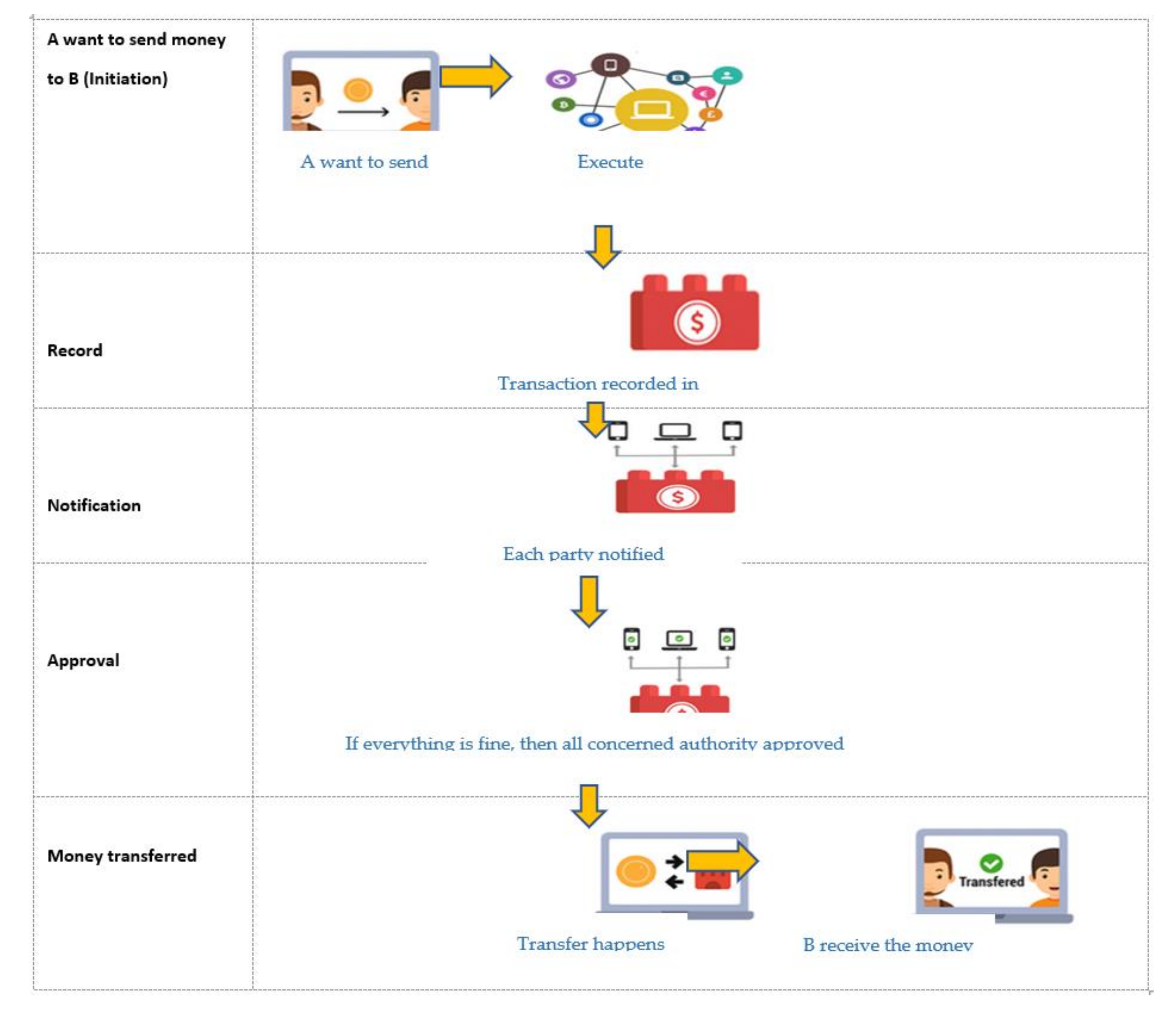
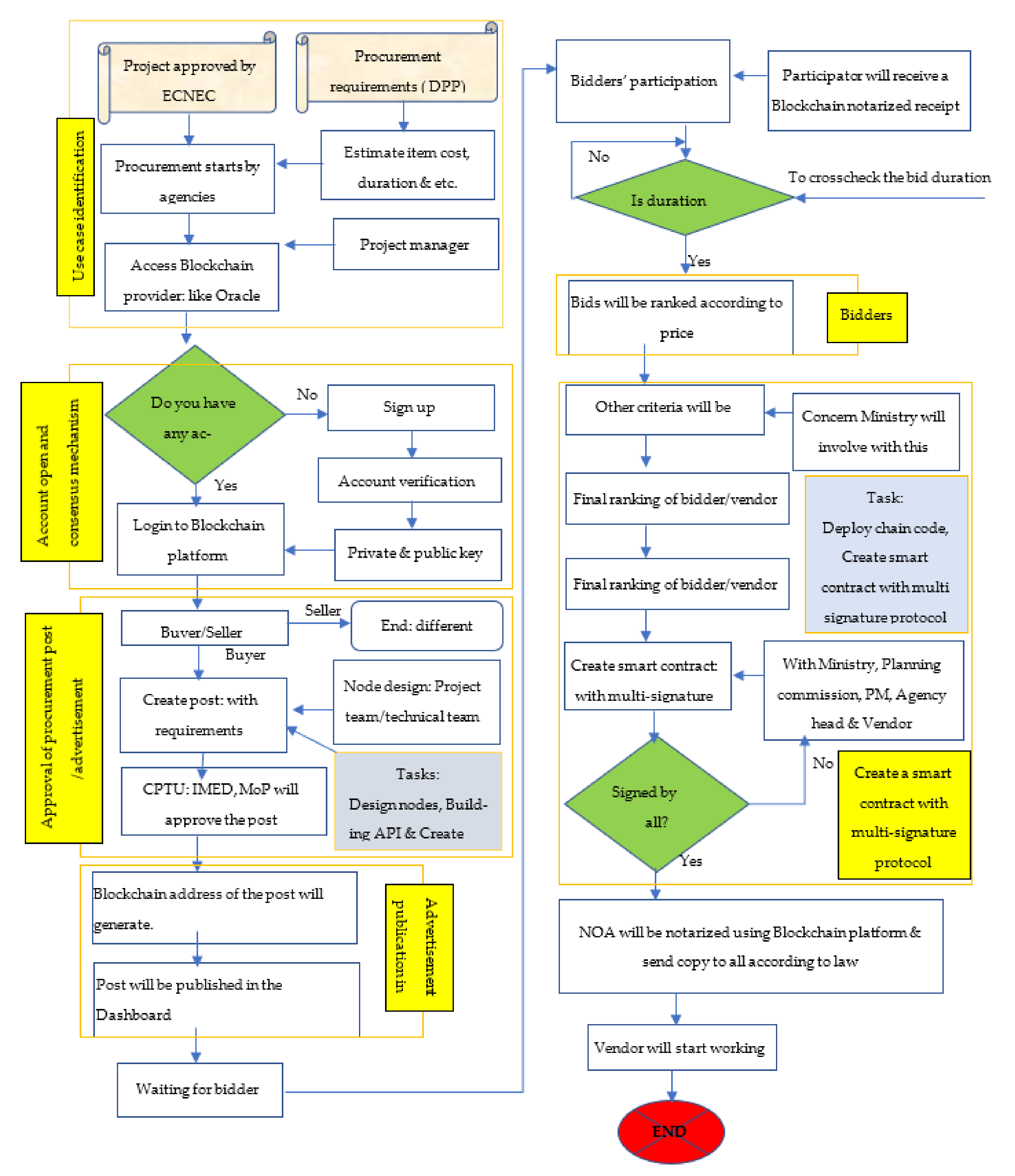
| SI | Issues | Themes | Identified after Investigating Projects/Samples | SI | Issues | Themes | Identified after Investigating Projects/Samples |
|---|---|---|---|---|---|---|---|
| S1 | Shortage of materials | Managerial | 15 | S21 | Contract awarded to lowest bidder | Legal | 374 |
| S2 | Unforeseen site conditions | Managerial | 85 | S22 | Inadequate site investigations | Managerial | 85 |
| S3 | Change in orders by client (variations) | Legal | 373 | S23 | Delay of drawings and site instructions | Legal | 85 |
| S4 | Price fluctuations (inflation) | Financial | 85 | S24 | Unsuitable construction methods | Managerial | 85 |
| S5 | Inaccurate estimates | Financial and Organisational | 373 | S25 | Acceleration required by client | Managerial | 15 |
| S6 | Poor site management by contractor | Managerial | 15 | S26 | Change in foreign exchange rate | Financial | 15 |
| S7 | Shortage of skilled labour | Organisational | 85 | S27 | Fraudulent practices, kickbacks, corruption | Legal | 16 |
| S8 | Lack of communication between parties | Managerial and Organisational | 85 | S28 | Owner’s fund shortage | Financial | 71 |
| S9 | Delayed payment of completed works | Financial | 85 | S29 | Improper progress monitoring and cost control | Legal and Organisational | 70 |
| S10 | Inadequate duration of contract period | Legal | 373 | S30 | Inaccurate time and cost estimation | Managerial and Organisational | 70 |
| S11 | Adverse weather | Organisational | 85 | S31 | Inexperienced project manager (PM)/frequent transfer of PM | Managerial and Organisational | 119 |
| S12 | Construction errors/defective works | Legal | 15 | S32 | Information manipulation (hiding negative information) | Legal and Organisational | 2 |
| S13 | Poor contract management | Legal | 373 | S33 | Consultant issues | Organisational | 70 |
| S14 | Inappropriate government policies | Legal | 85 | S34 | Lack of accountability for poor decisions | Legal | 70 |
| S15 | Work suspension owing to conflicts | Legal | 85 | S35 | National and local politics | Organisational | 71 |
| S16 | Incompetent subcontractors | Legal | 85 | S36 | Improper planning | Managerial and Organisational | 71 |
| S17 | Inadequate pre-construction study/feasibility study | Organisational | 422 | S37 | Land acquisition problems | Legal | 63 |
| S18 | Inappropriate procurement/contract type | Legal | 15 | S38 | Improper cost–benefit analysis in advance | Organisational | 1 |
| S19 | Slow inspection of completed works | Managerial and Organisational | 373 | S39 | Delay from tender invitation to issuance of work order | Legal | 63 |
| S20 | High cost of machinery | Financial | 85 | S40 | Improper examination of EPC/Turnkey contract | Legal | 50 |
| SI | Mitigation (May Resolve/May Partially Resolve/Cannot Resolve) | Key Points of Argument |
|---|---|---|
| S1 | May partially resolve | Tracking facility will ensure arrival date of materials in the project area. However, it cannot resolve the issue if the amount of materials ordered is too low |
| S2 | Cannot resolve | Unpredictable |
| S3 | May partially resolve | Automatic operation and controlling facilities will support this. However, it will depend on smart contracts |
| S4 | Cannot resolve | Unpredictable, as it depends on the economy |
| S5 | May resolve | Automatic document management Transparency and accountability |
| S6 | May resolve | Fast inspection will allow for identifying the future needs and possible risks |
| S7 | May partially resolve | Vendor management, automatic communication, and smart contracts |
| S8 | May resolve | Automatic communication feature |
| S9 | May resolve | Automatic and secured fund transfer through smart contracts |
| S10 | May resolve | E-procurement; on-time tendering system; transparency and accountability; provenance of materials; and automatic document management |
| S11 | Cannot resolve | Unpredictable, such as heavy rain, flood, earthquake, etc. |
| S12 | May partially resolve | Ensures accountability. Blockchain is considered to be a digital ledger. It is not possible to either alter, delete, or change any information |
| S13 | May resolve | Automatic and on-time tendering system Transparency, as all the concerned people will be responsible for making the contract |
| S14 | Cannot resolve | Depends on government |
| S15 | May resolve | Secured network system will ensure transparency and accountability; hence, possibility of conflict will be less |
| S16 | May resolve | Blacklist could be the solution if the subcontractor is found to be incompetent Transparency and accountability |
| S17 | May resolve | Blockchain system will be able to identify the responsible person |
| S18 | May resolve | A centralized and efficient team will ensure/choose the right contract type |
| S19 | May resolve | Blockchain system/smart contract will mitigate the issue |
| S20 | May resolve | Smart contract will ensure vendors participate in bidding process all over the world; hence, client will get a good-quality product with a low price |
| S21 | May resolve | Blacklist feature will prevent the lowest bidder from taking illegal advantages |
| S22 | Cannot resolve | Issue before project planning |
| S23 | May resolve | Smart contract will ensure on-time delivery |
| S24 | May partially resolve | Proper document management, accountability will support the resolution of the issue but it cannot eliminate it totally |
| S25 | May resolve | Automatic contract management and deadline will force the team to finish within the deadline |
| S26 | Cannot resolve | Depends on the economy |
| S27 | May resolve | Transparency, accountability, and automatic fund transfer will resolve corruption issues. Moreover, it is not possible to either alter, delete, or change any information within Blockchain. Hence, fraudulent practices will be resolved |
| S28 | May resolve | Automatic payment system will support the proper management of the funds |
| S29 | May resolve | Client will be able to track project on a daily basis |
| S30 | May resolve | Smart contract and automatic document management might resolve the issue |
| S31 | Cannot resolve | It depends on personal expertise or institutional experience |
| S32 | May resolve | Personal liability will prevent information manipulation |
| S33 | May resolve | International bidding will choose the most experienced consultant based on their previous performance |
| S34 | May resolve | Blockchain system ensures accountability by default through its working principles. Moreover, it will provide the facility to identify any person |
| S35 | Cannot resolve | Internal issue within a country |
| S36 | May resolve | Blockchain-based document management has the potentiality to create institutional knowledge for project planning |
| S37 | Cannot resolve | Depends on the land law of the country |
| S38 | Cannot resolve | Depends on the context |
| S39 | May resolve | Due to smart contracts, no one will be allowed to delay any tasks |
| S40 | May resolve | Transparency, accountability, employee liability, and smart contracts will ensure the proper examination of EPC contracts |
Publisher’s Note: MDPI stays neutral with regard to jurisdictional claims in published maps and institutional affiliations. |
© 2022 by the authors. Licensee MDPI, Basel, Switzerland. This article is an open access article distributed under the terms and conditions of the Creative Commons Attribution (CC BY) license (https://creativecommons.org/licenses/by/4.0/).
Share and Cite
Khalfan, M.; Azizi, N.; Haass, O.; Maqsood, T.; Ahmed, I. Blockchain Technology: Potential Applications for Public Sector E-Procurement and Project Management. Sustainability 2022, 14, 5791. https://doi.org/10.3390/su14105791
Khalfan M, Azizi N, Haass O, Maqsood T, Ahmed I. Blockchain Technology: Potential Applications for Public Sector E-Procurement and Project Management. Sustainability. 2022; 14(10):5791. https://doi.org/10.3390/su14105791
Chicago/Turabian StyleKhalfan, Malik, Neda Azizi, Omid Haass, Tayyab Maqsood, and Istiaq Ahmed. 2022. "Blockchain Technology: Potential Applications for Public Sector E-Procurement and Project Management" Sustainability 14, no. 10: 5791. https://doi.org/10.3390/su14105791
APA StyleKhalfan, M., Azizi, N., Haass, O., Maqsood, T., & Ahmed, I. (2022). Blockchain Technology: Potential Applications for Public Sector E-Procurement and Project Management. Sustainability, 14(10), 5791. https://doi.org/10.3390/su14105791








